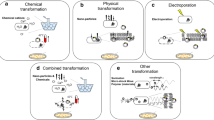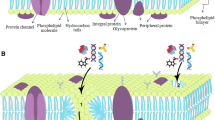Abstract
The nodulation regulon of Rhizobium meliloti AK631 includes several operons (nodABC, hsnABC, hsnD, efn locus) which have in common a consensus promoter sequence called the nod box. A synthetic nod box probe was used to identify two additional nod boxes, n4 and n5, which were subcloned for study. By constructing lac fusions, we show that n4 and n5 sponsor induction of downstream regions as previously shown for n1-nodABC and n2-hsnABC. Using site-directed Tn5 mutagenesis, we find that the n5 locus plays a significant role in nodulation of alfalfa and sweetclover, whereas the n4 locus is important for alfalfa, but not for sweetclover. Hybridization data suggest that the n5 locus is conserved among Rhizobium species. In contrast, the n4 locus seems to be unique to Rhizobium meliloti strains, in agreement with the host-specific phenotype of n4 locus mutants. Thus, the use of a promoter probe allows us to identify nodulation genes which may be overlooked by standard methods such as random Tn5 mutagenesis.
Similar content being viewed by others
References
Beringer JE: Transfer of the drug-resistance transposon Tn5 to Rhizobium. J Gen Microbiol 84: 188–189 (1974).
Castilho BA, Olfson P, Casadaban P: Plasmid insertion mutagenesis and lac gene fusion with mini-Mu bacteriophage transposons. J Bact 158: 488–495 (1984).
Ditta G., Stanfield S, Corbin D, Helinski DR: Broad host range DNA cloning system for Gram-negative bacteria: construction of a gene bank of Rhizobium meliloti. Proc Natl Acad Sci USA 77: 7347–7351.
Fahreus G: The infection of clover root hairs by nodule bacteria studied by a simple glass slide technique. J Gen Microbiol 16: 374–381 (1957).
Gottfert M, Horvath B, Kondorosi E, Putnoky P, Rodriguez-Quinones F, Kondorosi A: At least two nodD genes are necessary for efficient nodulation of alfalfa by Rhizobium meliloti. J Mol Biol 191: 411–420 (1986).
Groisman EA, Casadaban MJ: Mini-Mu bacteriophage with plasmid replicons for in vivo cloning and lac gene fusing. J Bact 168: 357–364 (1986).
Gyorgypal Z, Iyer N, Kondorosi A: Three regulatory nodD alleles of diverged flavonoid-specificity are involved in host-dependent nodulation by Rhizobium meliloti. Mol Gen Genet 212: 85–92 (1988).
Honma MA, Ausubel FM: Host specific nodulation: effects of multiple nodD genes of Rhizobium meliloti. In: Verma DPS, Brisson N (eds) Molecular Genetics of Plant-Microbe Interactions, pp. 223–224. Martinus Nijhoff, Dordrecht (1987).
Horvath B, Kondorosi E, John M, Schmidt J, Torok I, Gyorgypal Z, Barabas I, Wieneke U, Schell J, Kondorosi A: Organization, structure, and symbiotic function of Rhizobium meliloti nodulation genes determining host specificity for alfalfa. Cell 46: 335–343 (1986).
Horvath B, Bachem CWB, Schell J, Kondorosi A: Host-specific regulation of nodulation genes in Rhizobium is mediated by a plant signal, interacting with the nodD gene product. EMBO J 6: 841–848 (1987).
Knauf VC, Nester EW: Wide host range cloning vectors: A cosmid clone bank of an agrobacterium Ti plasmid. Plasmid 8: 45–54 (1982).
Kondorosi A, Svab B, Kiss GB, Dixon RA: Ammonia assimilation and nitrogen fixation in Rhizobium meliloti. Mol Gen Genet 151: 221–226 (1977).
Kondorosi A, Kondorosi E, Pankhurst EC, Broughton WJ, Banfalvi Z: Mobilization of a Rhizobum meliloti megaplasmid carrying nodulation and nitrogen fixation genes into other rhizobia and Agrobacterium. Mol Gen Genet 188: 433–439 (1982).
Kondorosi E, Banfalvi Z, Kondorosi A: Physical and genetic analysis of a symbiotic region of Rhizobium meliloti: Identification of nodulation genes. Mol Gen Genet 193: 445–452 (1984).
Kiss GB, Vincze E, Kalman E, Forrai T, Kondorosi A: Genetic and biochemical analysis of mutants affected in nitrate reduction in Rhizobium meliloti. J Gen Microbiol 113: 105–118 (1979).
Maniatis T, Fritsch EF, Sambrook J: Molecular Cloning: A Laboratory Manual. Cold Spring Harbor Laboratory, Cold Spring Harbor, NY (1982).
Miller JH: Experiments in Molecular Genetics. Cold Spring Harbor Laboratory, Cold Spring Harbor, NY (1972).
Mulligan JT, Long SR: Induction of Rhizobium meliloti nodC expression by plant exudate requires nodD. Proc Natl Acad Sci USA 82: 6609–6613 (1985).
Norrander J, Kempe T, Messing J: Improved M13 vectors using oligonucleotide-directed mutagenesis. Gene 26: 101–106 (1983).
Putnoky P, Kondorosi A: Two gene clusters of Rhizobium meliloti code for early essential nodulation functions and a third influences nodulation efficiency. J Bact 167: 881–887, (1986).
Quinto M, Bender RA: Use of bacteriophage P1 as a vector for Tn5 insertion mutagenesis. Appl Environ Microbiol 47: 436–438 (1984).
Ruvkun GB, Ausubel FM: A general method for site-directed mutagenesis in prokaryotes. Nature (London) 289: 81–88 (1981).
Ratet P, Schell J, deBruijn FJ: Mini-Mulac transposons with broad-host-range origins of conjugal transfer and replication designed for gene regulation studies in Rhizobiaceae. Gene 63: 41–52 (1988).
Renalier M, Batut J, Ghai J, Terzaghi B, Gherardi M, David M, Garnerone A, Vasse J, Truchet G, Huguet G, Boistard P: A new symbiotic cluster on the pSYM megaplasmid of Rhizobium meliloti 2011 carries a functional fix gene repeat and a nod locus. J Bact 169: 2231–2238 (1987).
Rostas K, Kondorosi E, Horvath B, Simoncsits A, Kondorosi A: Conservation of extended promoter regions of nodulation genes in Rhizobium. Proc Natl Acad Sci USA 83: 1757–1761 (1986).
Selvaraj G, Fong YC, Iyer VN: A portable DNA sequence carrying the cohesive site (cos) of bacteriophage lambda and the mob (mobilization) region of the broad-host-range plasmid RK2: a module for the construction of new cosmids. Gene 32: 235–241 (1984).
Spaink HP, Okker R, Wijffelman CA, Pees E, Lugtenberg B: Promoters in the Nodulation region of the Rhizobium leguminosarum SYM plasmid pRL1JI. Plant Mol Biol, in press (1988).
Author information
Authors and Affiliations
Rights and permissions
About this article
Cite this article
Gerhold, D., Stacey, G. & Kondorosi, A. Use of a promoter-specific probe to identify two loci from the Rhizobium meliloti nodulation regulon. Plant Mol Biol 12, 181–188 (1989). https://doi.org/10.1007/BF00020503
Received:
Accepted:
Issue Date:
DOI: https://doi.org/10.1007/BF00020503




